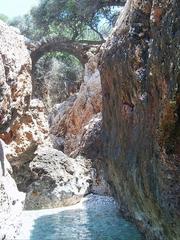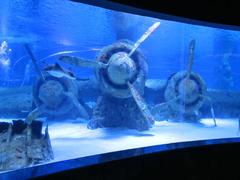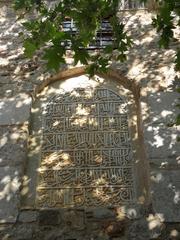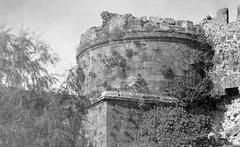
A Complete Guide to Aperlae: Visiting Hours, Tickets, and Antalya Historical Sites
Date: 14/06/2025
Introduction: Discovering Aperlae, Antalya’s Hidden Gem
Aperlae, a remarkable ancient Lycian city, lies tucked away on the southern Mediterranean coast of Turkey in Antalya Province. Founded around the 4th century BCE, Aperlae offers a unique opportunity to witness the legacy of Lycian urban life, maritime commerce, and cultural evolution across the Hellenistic, Roman, and Byzantine eras. Its well-preserved city walls, distinctive Lycian sarcophagi, and submerged harbor ruins make it especially captivating for history enthusiasts, hikers, and adventurous travelers seeking sites beyond Antalya’s usual tourist routes.
This comprehensive guide provides all the essential information for planning your visit to Aperlae, including current visiting hours, ticket details, travel tips, site highlights, practical advice, and suggestions for nearby attractions. For more in-depth resources, consult official tourism platforms like the Antalya Tourism Website and trusted travel guides such as Alaturca Cruises.
Table of Contents
- Introduction
- History and Archaeological Overview
- Main Features and Attractions
- Activities for Visitors
- Essential Visitor Information
- Getting There and Accessibility
- Practical Tips for Visiting
- Nearby Sites and Itinerary Ideas
- Frequently Asked Questions (FAQs)
- Visuals and Interactive Elements
- Related Resources and Internal Links
- Conclusion
History and Archaeological Overview
Foundation and Growth
Aperlae was established during the Early Hellenistic period (late 4th–2nd centuries BCE) as a fortified settlement, likely to protect local populations and maritime interests. Initially a military outpost or a defensive community, the city quickly became integrated into Lycian and then Roman spheres of influence.
Roman and Byzantine Prosperity
By the Roman era, Aperlae featured hallmarks of urban planning, such as bath complexes and a structured city layout. While not as grand as neighboring Myra, Aperlae was recognized as a vital maritime town by ancient writers like Pliny the Elder. Its prosperity was closely linked to the production of Tyrian purple dye, a prized luxury exported throughout the Mediterranean.
During Late Antiquity, Aperlae grew as a Christian bishopric, evidenced by the remains of a church complex and episcopal records. Large public buildings, fish tanks (vivaria), and ongoing trade testify to its significance during this period.
Decline and Preservation
Aperlae’s decline began in the 7th century CE, driven by factors such as Arab naval raids, shifting trade routes, and the silting of its harbor. Unlike many ancient cities, Aperlae was spared large-scale quarrying, so much of its monumental architecture remains intact today. Modern archaeological work consists mainly of surface and underwater surveys, as no formal excavations have been undertaken due to regulatory constraints (Alaturca Cruises).
Main Features and Attractions
City Walls and Fortifications
Imposing polygonal limestone walls, dating from the Hellenistic and Roman periods, enclose much of the ancient city. These fortifications offer panoramic views and a tangible sense of the city’s strategic priorities (Antalya Tourist Information).
Necropolis and Sarcophagi
Aperlae’s necropolis is renowned for its unique Lycian sarcophagi and barrel-vaulted tombs, which dot the slopes above the city. The necropolis provides insights into ancient burial customs and offers breathtaking coastal vistas (iAntalya).
Submerged Harbor and Maritime Remains
Due to tectonic activity and rising sea levels, parts of Aperlae’s harbor and associated warehouses are now submerged. The clear waters invite snorkeling and underwater exploration, revealing ancient quays, cisterns, and dye-processing vats (Alaturca Cruises).
Public Buildings and Urban Ruins
Within the city, visitors can see the remains of a basilica, bath complexes, and other communal structures, as well as occasional mosaic fragments—evidence of Aperlae’s civic life (iAntalya).
Activities for Visitors
- Hiking the Lycian Way: Aperlae is a highlight of the Lycian Way hiking trail, offering dramatic Mediterranean views and access to other Lycian sites (Lycian Way Hiking Trail).
- Snorkeling: The submerged ruins in the harbor are best explored by snorkeling, with local guides offering boat tours.
- Photography and Nature Observation: The blend of ancient ruins and unspoiled landscapes is ideal for photographers and nature lovers.
- Guided Tours: Historians and archaeologists offer guided visits, which can be arranged through Antalya or Kaş-based agencies (Alaturca Cruises).
Essential Visitor Information
Aperlae Visiting Hours and Tickets
- Opening Hours: Aperlae is accessible year-round from sunrise to sunset. There are no formal opening or closing times, as the site is undeveloped and open-air.
- Entrance Fee: There is no charge to visit Aperlae independently. Fees may apply for guided tours or boat excursions.
Facilities and Amenities
- Onsite Facilities: There are no restrooms, cafes, or shops at Aperlae. Visitors should bring sufficient water, snacks, and sun protection.
- Accessibility: The site features rough, uneven terrain not suitable for wheelchairs or those with limited mobility.
Getting There and Accessibility
- By Foot: Aperlae is a key stop on the Lycian Way. The most popular route is a 3-hour hike from Sahilkılınçlı village. Trail conditions are moderately challenging but reward visitors with spectacular coastal views (Tours Around Turkey).
- By Boat: Many visitors arrive by boat from Kaş or Üçağız; boat tours often include snorkeling stops and guided interpretation (Alaturca Cruises).
- By Car: No direct road access exists. Drivers can reach nearby villages like Sahilkılınçlı, then continue on foot.
Practical Tips for Visiting
- Best Time to Visit: Visit between April and October for mild weather, with spring and autumn being most comfortable for hiking and exploration.
- What to Bring: Sturdy walking shoes, at least 2 liters of water, snacks, sun protection (hat, sunscreen, sunglasses), swimwear, and snorkeling gear.
- Safety: Watch for wildlife, be cautious on rocky paths, and do not remove or disturb artifacts.
- Leave No Trace: Carry out all waste to preserve the site’s natural and archaeological integrity.
Nearby Sites and Itinerary Ideas
- Kekova and Simena (Kaleköy): Combine your visit with boat tours to the sunken city of Kekova and the hilltop fortress at Simena.
- Demre (Myra): Just 15 km away, Demre is famous for its rock-cut tombs and the Church of St. Nicholas.
- Kaş: A vibrant coastal town, ideal for overnight stays and arranging regional tours (The Turkey Traveler).
Frequently Asked Questions (FAQs)
Do I need a ticket to visit Aperlae?
No, the site is freely accessible; guided tours and boat excursions may have separate fees.
What are the official visiting hours?
Aperlae is open year-round during daylight hours; there are no enforced opening or closing times.
Are there facilities onsite?
No. Visitors should bring all necessary provisions.
Is the site suitable for families?
Yes, with supervision for children due to uneven paths and proximity to the sea.
Can I snorkel at Aperlae?
Yes, snorkeling among the submerged harbor ruins is a popular activity.
Visuals and Interactive Elements
- Images: High-resolution photos of city walls, necropolis, and underwater ruins, with alt text such as “Aperlae ancient city walls” and “Aperlae submerged harbor ruins.”
- Maps: Interactive maps illustrating Aperlae’s location and hiking routes along the Lycian Way.
- Virtual Tours: Check tourism websites for 360-degree panoramic views.
Related Resources and Internal Links
- Official Antalya Tourism Website
- Lycian Way Hiking Trail
- Guided Tours to Aperlae and Surrounding Sites
Conclusion
Aperlae stands out as one of Antalya’s most authentic and atmospheric ancient sites—perfect for travelers seeking a blend of history, adventure, and natural beauty. With no entrance fees, year-round accessibility, and a wealth of archaeological treasures, Aperlae invites visitors to experience the Lycian coast as it has remained for centuries. Plan your journey today, respect the site’s fragile environment, and immerse yourself in the layered history of this hidden gem. For updated travel tips, offline maps, and guided tour options, download the Audiala app and connect with fellow explorers on social media.
References and Official Links
- Antalya Tourism Website
- Tourist Places Guide
- Tours Around Turkey
- Alaturca Cruises
- iAntalya
- The Turkey Traveler
- Far Horizons





